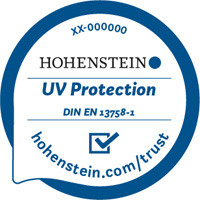Objective
This standard is used to determine the ultraviolet protection factor (= UPF) of textiles and similar materials (e.g. protective films) in a new condition without real usage.
The test is suitable for
- Clothing textiles
- Similar materials

Your benefit as a customer
- Consumer information with the specification of the UPF in its new condition
- Material optimisation during development
- Securing the product on the market
- Clear product information

Description
At Hohenstein, the UV protection is tested in the form of the UPF (=ultraviolet protection factor) of textiles. The UPF enables an assessment of the UV protection of textiles taking into account the spectral composition of sunlight and human skin sensitivity.
The test and certification criteria to determine the UPF are characterised as follows:
Test:
- New, unstretched and dry materials are tested. The basis is the solar spectrum for Albuquerque, New Mexico.
- The requirements of DIN EN 13758-2 are not used in the testing programme for the Hohenstein quality label.
Certification:
- The quality label may be issued on conclusion of a valid contract and adequate testing.
- It is issued based solely on the material test as per DIN EN 13758-1 and the sufficiently modified classification as per AS/NZS 4399 with the levels UPF 15, 30, 50 or 50+
Depending on the product, modifications are also possible, e.g. with regard to pretreatments.
Material testing and certification based on this standard is generally recognised as proof within the context of regulation (EU) 2016/425 on personal protective clothing. The final product must meet all other requirements of the regulation.